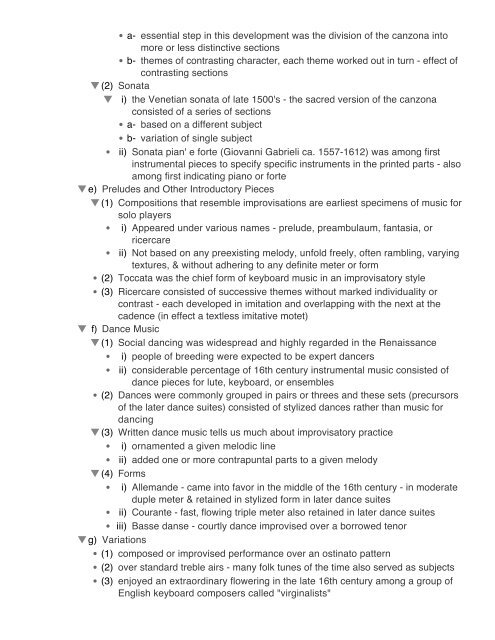An Outline of The History of Western Music Grout ... - The Reel Score
An Outline of The History of Western Music Grout ... - The Reel Score
An Outline of The History of Western Music Grout ... - The Reel Score
Create successful ePaper yourself
Turn your PDF publications into a flip-book with our unique Google optimized e-Paper software.
a- essential step in this development was the division <strong>of</strong> the canzona into<br />
more or less distinctive sections<br />
b- themes <strong>of</strong> contrasting character, each theme worked out in turn - effect <strong>of</strong><br />
contrasting sections<br />
(2) Sonata<br />
i) the Venetian sonata <strong>of</strong> late 1500's - the sacred version <strong>of</strong> the canzona<br />
consisted <strong>of</strong> a series <strong>of</strong> sections<br />
a- based on a different subject<br />
b- variation <strong>of</strong> single subject<br />
ii) Sonata pian' e forte (Giovanni Gabrieli ca. 1557-1612) was among first<br />
instrumental pieces to specify specific instruments in the printed parts - also<br />
among first indicating piano or forte<br />
e) Preludes and Other Introductory Pieces<br />
(1) Compositions that resemble improvisations are earliest specimens <strong>of</strong> music for<br />
solo players<br />
i) Appeared under various names - prelude, preambulaum, fantasia, or<br />
ricercare<br />
ii) Not based on any preexisting melody, unfold freely, <strong>of</strong>ten rambling, varying<br />
textures, & without adhering to any definite meter or form<br />
(2) Toccata was the chief form <strong>of</strong> keyboard music in an improvisatory style<br />
(3) Ricercare consisted <strong>of</strong> successive themes without marked individuality or<br />
contrast - each developed in imitation and overlapping with the next at the<br />
cadence (in effect a textless imitative motet)<br />
f) Dance <strong>Music</strong><br />
(1) Social dancing was widespread and highly regarded in the Renaissance<br />
i) people <strong>of</strong> breeding were expected to be expert dancers<br />
ii) considerable percentage <strong>of</strong> 16th century instrumental music consisted <strong>of</strong><br />
dance pieces for lute, keyboard, or ensembles<br />
(2) Dances were commonly grouped in pairs or threes and these sets (precursors<br />
<strong>of</strong> the later dance suites) consisted <strong>of</strong> stylized dances rather than music for<br />
dancing<br />
(3) Written dance music tells us much about improvisatory practice<br />
i) ornamented a given melodic line<br />
ii) added one or more contrapuntal parts to a given melody<br />
(4) Forms<br />
i) Allemande - came into favor in the middle <strong>of</strong> the 16th century - in moderate<br />
duple meter & retained in stylized form in later dance suites<br />
ii) Courante - fast, flowing triple meter also retained in later dance suites<br />
iii) Basse danse - courtly dance improvised over a borrowed tenor<br />
g) Variations<br />
(1) composed or improvised performance over an ostinato pattern<br />
(2) over standard treble airs - many folk tunes <strong>of</strong> the time also served as subjects<br />
(3) enjoyed an extraordinary flowering in the late 16th century among a group <strong>of</strong><br />
English keyboard composers called "virginalists"





